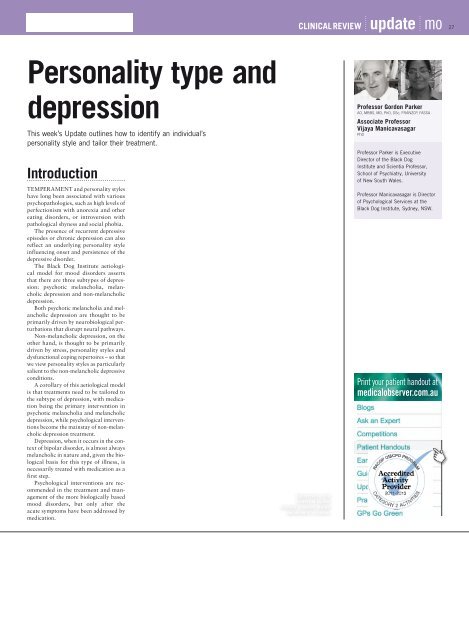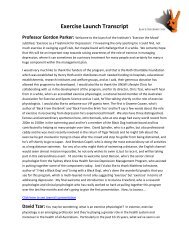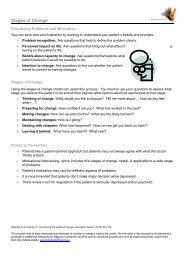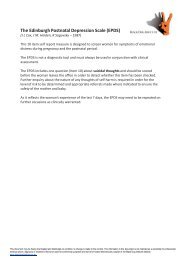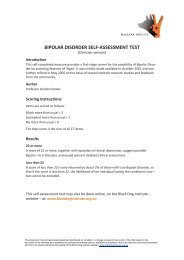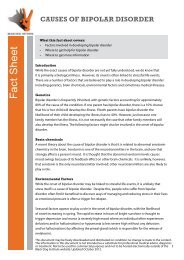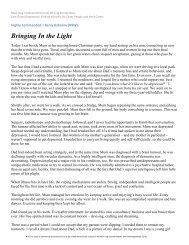Personality type and depression - Black Dog Institute
Personality type and depression - Black Dog Institute
Personality type and depression - Black Dog Institute
Create successful ePaper yourself
Turn your PDF publications into a flip-book with our unique Google optimized e-Paper software.
28 mo update clinical review<strong>Personality</strong> <strong>type</strong> <strong>and</strong> <strong>depression</strong>Further research conducted at the formerMood Disorders Unit <strong>and</strong>, later, at the<strong>Black</strong> <strong>Dog</strong> <strong>Institute</strong> in Sydney has identifiedat least eight personality stylesof salience to non-melancholic <strong>depression</strong>,which is one of the most frequentlyoccurring categories of mood disorders<strong>and</strong> accounts for about 90% of <strong>depression</strong>sseen in clinical practice.<strong>Personality</strong> styles, which usually manifestin the cognitive <strong>and</strong> behaviouraldomains, are affected by psychosocialstressors, which, in turn, can compromisean individual’s self-esteem <strong>and</strong>ability to cope, thus exacerbating theimpact of the original stressor <strong>and</strong> causing<strong>depression</strong> onset.In addition, particular personalitystyles can sometimes increase the likelihoodof stressful events.For example, an individual with arejection-sensitive personality style, whois prone to interpreting events with a biastowards rejection <strong>and</strong> ab<strong>and</strong>onment byothers, is more likely to manifest clingy,dependent behaviours, which make themmore likely to actually be rejected byothers.Although, <strong>and</strong> as noted, this cycle isparticularly relevant for the development<strong>and</strong> maintenance of non-melancholic<strong>depression</strong>s, dysfunctional personalitycharacteristics can also play a significantrole in the maintenance of other<strong>type</strong>s of mood disorders, including melancholic<strong>depression</strong> <strong>and</strong> bipolar disorder.While the primary drivers for these <strong>type</strong>sof mood disorders are considered to beneurobiological, maladaptive cognitions<strong>and</strong> behaviours can still impact on thecourse of recovery.For example, individuals with melancholic<strong>depression</strong> <strong>and</strong> a perfectionist personalitystyle may initially respond wellto antidepressant medication, but continueto criticise themselves about sufferingfrom <strong>depression</strong> <strong>and</strong> worry aboutthe process of recovery. This level of selfcriticism<strong>and</strong> worry may be sufficient toretard their rate of improvement fromthe <strong>depression</strong> <strong>and</strong>/or increase their likelihoodof relapse.Different personality stylesThe personality styles identified in thesubtyping model for <strong>depression</strong> are perfectionistic,socially avoidant, anxious worrier,irritable, socially reserved, rejectionsensitive, self-focused, <strong>and</strong> self-critical.These personality styles are thoughtto be subsumed by the neurobiologicalunderpinnings of temperament, such thatthose with the more ‘externalising’ constructsof personality styles, for example,irritable or self-focused, are more likely to‘blow up’ when upset or engage in recklessor impulsive behaviours when depressed.While individuals with these <strong>type</strong>s ofpersonality styles are more likely to experiencetransient depressive episodes, thepeople around them may experience ‘collateraldamage’ as a consequence of theireternalising response style.In contrast to ‘externalisers’, personalitystyles that reflect an ‘internalising’construct, such as the anxious worrier orrejection sensitive, are more likely to stewover specific events, worry <strong>and</strong> seek reassurancefrom others.As noted earlier, personality stylescan influence vulnerability to depressiveepisodes, exposure to environmentalstressors, symptom patterns in non-melancholic<strong>depression</strong> <strong>and</strong> response to treatment.These points can be best illustratedwith the two most common personalitystyles seen by clinicians, that of the anxiousworrier <strong>and</strong> the perfectionist.Treating the anxious worrierIndividuals with an anxious-worryingpersonality style are characterised by highlevels of autonomic arousal, a tendency toworry, <strong>and</strong> increased vulnerability to nonmelancholic<strong>depression</strong>.When depressed, they typically presentwith significant physical <strong>and</strong> cognitivesymptoms of anxiety, including ruminations,catastrophic thoughts <strong>and</strong> self-doubt.Their chronic worry may result inrepeated reassurance-seeking from familymembers, friends <strong>and</strong> health professionals.In addition, a range of avoidancebehaviours may complicate their clinicalpresentation <strong>and</strong> result in lifestyle restrictions,such as avoiding social situationsor taking on new challenges <strong>and</strong> responsibilitiesat work.Treating an individual with an anxious-worryingpersonality can includemedications such as SSRIs to reduce anxiety<strong>and</strong> curb worry, together with a rangeof psychological interventions to addresstheir concerns <strong>and</strong> negative thinkingstyles.These psychological strategies caninclude relaxation <strong>and</strong> meditation exercises,problem-solving strategies, goalsetting<strong>and</strong> time-management skills, <strong>and</strong>cognitive behavioural therapy in order tolearn how to challenge <strong>and</strong> change maladaptivecatastrophic thoughts.Perfectionists donot usually benefitfrom antidepressantmedication.iStockphoto.comTreating the perfectionistThe anxiety often observed in individualswith a perfectionistic personalityis somewhat different in aetiology tothat for the anxiety worrier. While theanxious worrier may stew over currentevents, experience catastrophic thoughtsabout events <strong>and</strong> seek reassurance fromothers, perfectionists typically are proneto self-criticism, fear of failure <strong>and</strong> makingthe ‘wrong’ decisions, ruminationsover past behaviours <strong>and</strong> feeling overwhelmed.Perfectionists are also less likely tosolicit others for help or to seek professionaladvice when depressed.‘Behavioural paralysis’ <strong>and</strong> procrastinationare usually related to anxietiesover making a wrong decision or notbeing able to complete a task as well asexpected.Unlike anxious worrying, perfectionismas a personality characteristicis usually somewhat protective against<strong>depression</strong> onset. Their self-imposedhigh st<strong>and</strong>ards, self-discipline <strong>and</strong> controlnot only ensure high productivity<strong>and</strong> achievement, but also lessen thelikelihood of being exposed to, <strong>and</strong>becoming overwhelmed by, unexpectedstressors. However, once they are overwhelmedby uncontrollable stressors,perfectionist individuals are slower torecover <strong>and</strong> return to their previous levelof functioning.In treatment for a depressive illness,perfectionists do not usually benefitfrom antidepressant medications asthey prefer to be ‘in control’ rather thansurrendering such control to medication.In addition, their <strong>depression</strong> is generallyunderpinned by a sense of failingto meet goals or st<strong>and</strong>ards ratherthan being due to emotional dysregulation(which is prevalent in anxiousworrying).Finally, the need for control actsagainst any likelihood for spontaneousremission <strong>and</strong> improvement, thus weakeninga possible springboard for a therapeuticresponse.Psychological therapies also face significantchallenges when used with theperfectionist patient, who may experiencedifficulty in trusting their GP ortherapist <strong>and</strong> forming any, let alone astrong, treatment alliance. Hence thewidespread perception among cliniciansthat, once depressed, perfectionists aredifficult to treat <strong>and</strong> that their <strong>depression</strong>sdo not quickly remit.13 APRil 2012
clinical review update mo29Treating biological <strong>depression</strong>For the more biologically based mooddisorders, personality styles can alsoinfluence the ways in which individualscope with their <strong>depression</strong> <strong>and</strong> the <strong>type</strong>sof psychological interventions that maybe helpful once the acute symptoms havebegun to remit.For example, an individual with amelancholic <strong>depression</strong> together with asocially avoidant personality style maybecome more avoidant while depressed,but is unlikely to be the life <strong>and</strong> soulof a party even when their <strong>depression</strong>improves.Although their therapist may referthem for group social skills training orother group-based programs, an individualwith a socially avoidant personalitystyle is unlikely to comply with such atreatment approach despite the obviousbenefits.Psychological strategies will firstlyneed to harness their motivation toaddress their anxieties about social situations<strong>and</strong>, secondly, apply skills trainingor cognitive restructuring on anindividual basis, at least until they feelcomfortable attending any group-basedinterventions.Recurrent depressive episodes orchronic <strong>depression</strong> can reflect an underlyingpersonality style influencing persistenceof the depressive disorder.KEY POinTSn There are three sub<strong>type</strong>s of<strong>depression</strong>: psychotic melancholia,melancholic <strong>depression</strong> <strong>and</strong> nonmelancholic<strong>depression</strong>.n Non-melancholic <strong>depression</strong> is drivenby stress, personality styles <strong>and</strong>dysfunctional coping repertoires.n Psychotic melancholia <strong>and</strong>melancholic <strong>depression</strong> are thoughtto be primarily driven byneurobiological pathways.<strong>Personality</strong> styles vs personality disordersOne important point to remember is thatpersonality styles are not synonymous withpersonality disorders. <strong>Personality</strong> styles areenduring characteristics that affect the wayin which individuals perceive themselves,underst<strong>and</strong> life events, cope with stress <strong>and</strong>interact with others. In this way, personalitystyles may be adaptive for an individual’slifestyle or social <strong>and</strong> cultural niche, ormaladaptive if they lead to ongoing psychosocialdifficulties.<strong>Personality</strong> styles are shaped by social<strong>and</strong> cultural influences, early life experiencessuch as quality of parental care orexperiences of abuse, as well as ‘temperament’(i.e. the neuronal ‘hardwiring’ thatunderpins the expression of certain behaviouralcharacteristics such as shyness).In contrast, personality disorders arehighly dysfunctional ways of thinking,behaving, coping with stressful life events<strong>and</strong> interacting with others. Individualswith clearly defined personality disordersexhibit significant impairments in their lives.While personality styles themselves areconsidered to be unchangeable, the ways inwhich they are expressed may be open tomodification. For example, an individualwith a socially reserved personality stylemay find it difficult to confide in or trustothers. They may have a number of superficialfriends, but find interactions with themneither rewarding nor uplifting. They mayyearn for emotional closeness, but not possessthe necessary skills to develop closerfriendships or deeper relationships.If sufficiently motivated, an individualwith a socially reserved personality stylemay be instructed in skills to challenge theirdysfunctional thoughts about trusting otherpeople, express their feelings to others, <strong>and</strong>organise social occasions in which to practisethese skills.For clinicians, helping patients shift theirmaladaptive thoughts <strong>and</strong> behaviours tomore adaptive expressions can be helpful inreducing distress <strong>and</strong> promoting recoveryfrom mood disorders (e.g. various maladaptivethoughts are associated with perfectionism,such as harsh self-criticism <strong>and</strong> loss ofself-esteem when facing failure).Perfectionist individuals tend to investtheir identity <strong>and</strong> sense of self in the successfulcompletion of tasks, <strong>and</strong> thus tend to‘beat themselves up’ over perceived failure.Helping perfectionist individuals to developa strong self-identity that is independentof task completion can help to break thevicious cycle comprising fears of failure,harsh self-criticism <strong>and</strong> loss of self-esteem.Assessment <strong>and</strong> management<strong>Personality</strong> styles can be reliably (<strong>and</strong>anonymously) assessed using the <strong>Black</strong><strong>Dog</strong> <strong>Institute</strong>’s Temperament <strong>and</strong> <strong>Personality</strong>Questionnaire (T&P questionnaire),which is available on the website (www.black doginstitute.org.au).The T&P is a validated self-reportmeasure that assesses all eight personalitystyles found in depressive disorders. It providesa score for each of the styles, so it ispossible for individuals to load highly onmore than one (e.g. social avoidance <strong>and</strong>rejection sensitivity).Information about high scores on eachof the personality subscales can be usedto inform psychological approaches tomanaging mood disorders <strong>and</strong> preventingrelapse.Another tool developed by the institutefor GPs is the Mood Assessment Program(MAP), which is aimed at improving diagnosticaccuracy in <strong>depression</strong> sub<strong>type</strong>s <strong>and</strong>in diagnosing bipolar disorder. Apart fromincorporating the T&P questionnaire, theMAP also inquires about current <strong>and</strong> paststresses, thus providing clinicians with aclearer picture of how these personalitystyles may have impacted on the development<strong>and</strong> maintenance of a mood disorder.In addition, the <strong>Black</strong> <strong>Dog</strong> <strong>Institute</strong> runstraining workshops for GPs <strong>and</strong> otherhealth professionals overviewing the diagnosis<strong>and</strong> management of mood disorders.These courses detail the issues involved inassessing <strong>and</strong> treating patients whose personalitystyles have significantly impactedon the development <strong>and</strong> maintenance of amood disorder. This is especially relevantfor those patients whose <strong>depression</strong>s do noteasily remit <strong>and</strong> where recurrent episodesare ongoing features. For the references <strong>and</strong> patient h<strong>and</strong>out,‘Depression’, go to medobs.com.au


